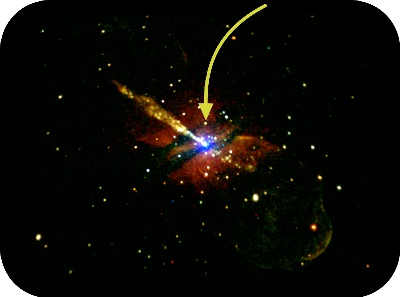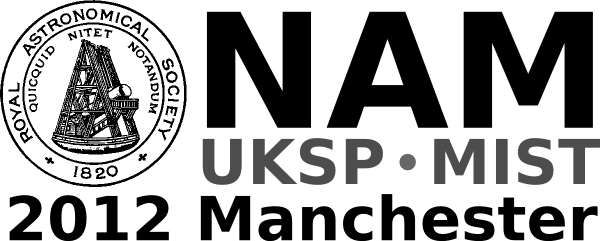UK-Germany National Astronomy Meeting NAM2012
'Ordinary' black hole discovered 12 million light years away
Royal Astronomical Society press release
RAS PR 12/20 (NAM 11)
Tuesday 27 March 2012

The yellow arrow in the picture identifies the position of the black hole transient inside Centaurus A. The location of the object is coincident with gigantic dust lanes that obscure visible and X-ray light from large regions of Centaurus A. Other interesting X-ray features include the central active nucleus, a powerful jet and a large lobe that covers most of the lower-right of the image. There is also a lot of hot gas. In the image, red indicates low energy, green represents medium energy, and blue represents high energy light. Credit: NASA / Chandra
An international team of scientists have discovered an 'ordinary' black hole in the 12 million light year-distant galaxy Centaurus A. This is the first time that a normal-size black hole has been detected away from the immediate vicinity of our own Galaxy. PhD student Mark Burke will present the discovery at the National Astronomy Meeting in Manchester.
Although exotic by everyday standards, black holes are everywhere. The lowest-mass black holes are formed when very massive stars reach the end of their lives, ejecting most of their material into space in a supernova explosion and leaving behind a compact core that collapses into a black hole. There are thought to be millions of these low-mass black holes distributed throughout every galaxy. Despite their ubiquity, they can be hard to detect as they do not emit light so are normally seen through their action on the objects around them, for example by dragging in material that then heats up in the process and emits X-rays. But despite this, the overwhelming majority of black holes have remained undetected.
In recent years, researchers have made some progress in finding ordinary black holes in binary systems, by looking for the X-ray emission produced when they suck in material from their companion stars. So far these objects have been relatively close by, either in our own Milky Way Galaxy or in nearby galaxies in the so-called Local Group (a cluster of galaxies relatively near the Milky Way that includes Andromeda).
Mr Burke works under the supervision of Birmingham University astronomer Dr Somak Raychaudhury and is part of an international team led by Ralph Kraft of the Harvard-Smithsonian Center for Astrophysics. The team used the orbiting Chandra X-ray observatory to make six 100,000-second long exposures of Centaurus A, detecting an object with 50,000 times the X-ray brightness of our Sun. A month later, it had dimmed by more than a factor of 10 and then later by a factor of more than 100, so became undetectable.
This behaviour is characteristic of a low mass black hole in a binary system during the final stages of an outburst and is typical of similar black holes in the Milky Way. It implies that the team made the first detection of a normal black hole so far away, for the first time opening up the opportunity to characterise the black hole population of other galaxies.
Mr Burke comments: "So far we've struggled to find many ordinary black holes in other galaxies, even though we know they are there. To confirm (or refute) our understanding of the evolution of stars we need to search for these objects, despite the difficulty of detecting them at large distances. If it turns out that black holes are either much rarer or much more common in other galaxies than in our own it would be a big challenge to some of the basic ideas that underpin astronomy."
The group now plan to look at the more than 50 other bright X-ray sources that reside within Centaurus A, identifying them as black holes or other exotic objects, and gain at least an inkling of the nature of a further 50 less luminous sources.
IMAGE AND CAPTION
The Chandra image of the low-mass black hole in Centaurus A can be downloaded from http://www.sr.bham.ac.uk/~somak/CenA/
Caption: The yellow arrow in the picture identifies the position of the black hole transient inside Centaurus A. The location of the object is coincident with gigantic dust lanes that obscure visible and X-ray light from large regions of Centaurus A. Other interesting X-ray features include the central active nucleus, a powerful jet and a large lobe that covers most of the lower-right of the image. There is also a lot of hot gas. In the image, red indicates low energy, green represents medium energy, and blue represents high energy light. Credit: NASA / Chandra
FURTHER INFORMATION
The new work will appear in, "A Transient Sub-Eddington Black Hole X-ray Binary Candidate in the Dust Lanes of Centaurus A", M. Burke et al, Astrophysical Journal. A preprint of the paper can be downloaded from http://arxiv.org/abs/1202.3149MEDIA CONTACTS
NAM 2012 Press Office (0900 - 1730 BST, 27-29 March; 0900 - 1630 BST 30 March)
Room 3.214
University Place building
University of Manchester
Manchester
UK
Tel: +44 (0)161 306 7313
Dr Robert Massey
Royal Astronomical Society
Mob: +44 (0)794 124 8035
Email: rm@ras.org.uk
Anita Heward
Royal Astronomical Society
Mob: +44 (0)7756 034 243
Email: anitaheward@btinternet.com
Dr Klaus Jaeger
Pressereferent / Press Officer im Vorstand der Astronomischen Gesellschaft
Tel: +49 6221 528 379
Email: pressereferent@astronomische-gesellschaft.de
Dan Cochlin
Media Officer (Faculty of Engineering and Physical Sciences)
University of Manchester
Tel: +44 (0)161 275 8387
Email: daniel.cochlin@manchester.ac.uk
SCIENCE CONTACTS
Mark Burke
Astrophysics and Space Research Group
University of Birmingham
Tel: +44 (0)121 415 8410
Email: mburke@star.sr.bham.ac.uk
Dr Somak Raychaudhury
Astrophysics and Space Research Group
University of Birmingham
Tel: +44 (0)121 414 6474
Email: somak@star.sr.bham.ac.uk
NOTES FOR EDITORS
NAM 2012
Bringing together more than 900 astronomers and space scientists, the National Astronomy Meeting (NAM 2012) will take place from 27-30 March 2012 in the University Place conference centre at the University of Manchester in the UK. The conference is a joint meeting of the Royal Astronomical Society (RAS) and the German Astronomische Gesellschaft (AG) and is held in conjunction with the UK Solar Physics (UKSP: www.uksolphys.org) and Magnetosphere Ionosphere Solar Terrestrial (MIST: www.mist.ac.uk) meetings. NAM 2012 is principally sponsored by the RAS, AG, STFC and the University of Manchester.
The Royal Astronomical Society
The Royal Astronomical Society (RAS: www.ras.org.uk), founded in 1820, encourages and promotes the study of astronomy, solar-system science, geophysics and closely related branches of science. The RAS organises scientific meetings, publishes international research and review journals, recognizes outstanding achievements by the award of medals and prizes, maintains an extensive library, supports education through grants and outreach activities and represents UK astronomy nationally and internationally. Its more than 3500 members (Fellows), a third based overseas, include scientific researchers in universities, observatories and laboratories as well as historians of astronomy and others.
The Astronomische Gesellschaft (AG)
The Astronomische Gesellschaft (AG: www.astronomische-gesellschaft.de), founded in 1863, is a modern astronomical society with more than 800 members dedicated to the advancement of astronomy and astrophysics and the networking between astronomers. It represents German astronomers, organises scientific meetings, publishes journals, offers grants, recognises outstanding work through awards and places a high priority on the support of talented young scientists, public outreach and astronomy education in schools.
The Science and Technology Facilities Council
The Science and Technology Facilities Council (STFC: www.stfc.ac.uk) is keeping the UK at the forefront of international science and tackling some of the most significant challenges facing society such as meeting our future energy needs, monitoring and understanding climate change, and global security. The Council has a broad science portfolio and works with the academic and industrial communities to share its expertise in materials science, space and ground-based astronomy technologies, laser science, microelectronics, wafer scale manufacturing, particle and nuclear physics, alternative energy production, radio communications and radar. It enables UK researchers to access leading international science facilities for example in the area of astronomy, the European Southern Observatory.
Jodrell Bank Centre for Astrophysics
The Jodrell Bank Centre for Astrophysics (JBCA: www.jb.man.ac.uk) is part of the School of Physics & Astronomy at the University of Manchester. JBCA is split over two main sites: the Alan Turing Building in Manchester and the Jodrell Bank Observatory in Cheshire. At Jodrell Bank Observatory, the new Jodrell Bank Discovery Centre is a key focus for our work in public engagement and education. Jodrell Bank is a world leader in radio astronomy-related research and technology development with a research programme extending across much of modern astrophysics. The group operates the e-MERLIN national radio astronomy facility and the iconic Lovell Telescope, hosts the UK ALMA Regional Centre Node and is home to the international office of the SKA Organisation. Funded by the University, the Science & Technology Facilities Council and the European Commission, it is one of the UK's largest astrophysics research groups.





